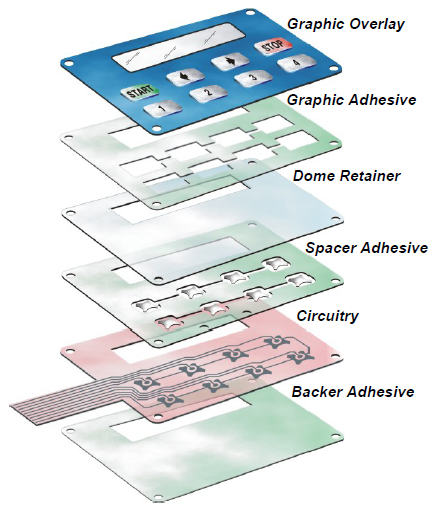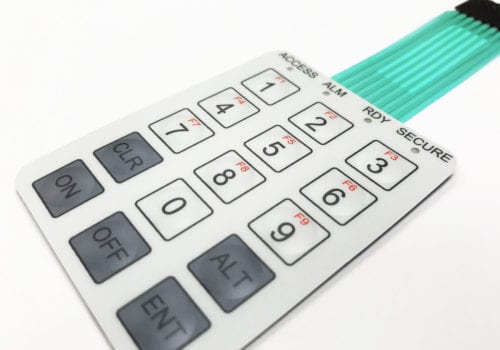Membrane Layer Switch Over Technology: The Secret to Trusted and Cost-efficient Interfaces
Membrane layer button technology has emerged as a crucial component in the style of interface, giving both reliability and cost-effectiveness across a diverse variety of applications. Its durable building and construction ensures resistance to environmental difficulties, while the versatility in layout permits tailored services that satisfy details market demands. As we explore the diverse advantages of membrane layer switches, their capacity for advancement elevates inquiries concerning future applications and advancing fads. What does the following phase hold for this technology in an increasingly digital landscape?
Recognizing Membrane Layer Change Innovation
Membrane button modern technology is an extensively used user interface option in various electronic gadgets, using a seamless blend of capability and style. This technology includes numerous layers of materials, normally containing a graphic overlay, spacer layer, and a circuit layer. The graphic overlay displays the interface elements, while the spacer layer divides the circuit layer from the overlay till an individual activates a button.
When pressure is applied to the overlay, the circuit layer finishes the electric circuit, sending a signal to the tool. This system enables numerous setups, including responsive comments and backlighting options, boosting user communication. Membrane buttons are normally manufactured making use of long lasting materials such as polyester or polycarbonate, ensuring longevity and resistance to ecological elements like dampness and dust.
The convenience of membrane layer switches enables their application in varied industries, consisting of medical gadgets, consumer electronic devices, and commercial controls. Their small design enables for assimilation into space-constrained settings, providing a reliable customer interface without endangering aesthetic charm. Recognizing the complexities of membrane layer switch modern technology is necessary for makers and designers seeking to develop dependable and efficient human-machine user interfaces.
Key Advantages of Membrane Switches
While different user interface solutions exist, membrane layer switches offer distinct benefits that make them a recommended choice in various applications. Among the key benefits is their longevity; membrane switches are developed to stand up to rough environmental problems, consisting of dampness, dust, and temperature level variations, ensuring lasting performance. This resilience dramatically reduces the need for frequent replacements, therefore decreasing total maintenance prices.

Additionally, membrane switches are lightweight and portable, making them appropriate for applications where area is limited. Their inconspicuous layout adds to a smooth appearance without compromising functionality.
Cost-effectiveness is additionally a remarkable benefit, as the manufacturing procedure for membrane layer changes tends to be cheaper compared to traditional mechanical buttons. This cost, combined with their integrity and simplicity of setup, settings membrane switches as a practical solution for a variety of markets seeking efficient and reliable individual interfaces.
Applications Across Different Industries
How do membrane layer buttons adapt to the varied demands of different markets? Membrane layer switch innovation is increasingly acknowledged for its convenience, making it suitable for a large array of applications across multiple markets.
In customer electronic devices, membrane switches give a portable option for remotes and home appliances, enhancing customer experience via intuitive style. Furthermore, the commercial field leverages membrane layer buttons for equipment control panels, taking advantage of their resistance to severe atmospheres, such as dampness and dirt.
Army and aerospace applications also utilize membrane switches for their reliability and capability to stand up to severe problems, making sure functional performance in critical situations. The food and beverage industry takes on these buttons for my latest blog post automated systems, where hygiene and convenience of procedure are extremely important (membrane switch). Inevitably, membrane layer switches are tailored to meet the unique needs of each market, showing their necessary role in modern innovation user interfaces
Style and Personalization Options

In the world of membrane layer switch technology, layout and personalization alternatives play an essential function in boosting capability and individual interaction. These buttons can be customized to meet details functional requirements and visual choices, making them versatile parts in different applications.
One of the primary modification choices is the layout of the button itself, which can be created to accommodate special interface and ergonomic considerations. By adjusting the shape, dimension, and plan of switches, producers can develop user-friendly layouts that help with convenience of use. In addition, the incorporation of different shades and graphic overlays permits for branding and enhanced presence, ensuring that individuals can promptly determine functions.
Additionally, membrane switches can be crafted with various responsive responses mechanisms, such as click for more info raised buttons or distinct clicks, to enhance the individual experience. Various materials can also be chosen for sturdiness and ecological resistance, attending to elements such as wetness, temperature level fluctuations, and chemical exposure.
Inevitably, the extensive layout and personalization choices readily available in membrane button technology empower services to develop tailored remedies that not only meet practical needs yet also align with their branding and operational demands.

Future Fads in Membrane Switches
As membrane switch innovation proceeds to develop, future fads are increasingly concentrated on improving individual experience and incorporating advanced functionalities. One considerable fad is the assimilation of touch-sensitive and capacitive technologies into conventional membrane layer buttons. This growth allows for more intuitive interface, offering tactile feedback while maintaining a sleek layout.
Another arising fad is making use of eco-friendly materials, driven by the growing need for lasting production techniques. Producers are seeking to reduce their carbon footprint by utilizing recyclable substrates and low-impact inks, aligning with global sustainability i was reading this goals.
Additionally, the increase of the Web of Things (IoT) is triggering the consolidation of smart features right into membrane layer buttons. Boosted connection choices will make it possible for tools to communicate with each other, permitting smooth assimilation into wider systems.
In addition, advancements in printing modern technologies, such as digital printing, are permitting greater layout versatility and personalization. This enables suppliers to generate complex designs and vibrant shades cost-effectively.

Conclusion
To conclude, membrane layer switch modern technology stands for a crucial development in user interface design, supplying considerable advantages in durability, modification, and cost-effectiveness. Its extensive applicability throughout varied markets underscores its value in modern-day technology. As innovations continue to emerge, specifically in touch-sensitive interfaces and sustainable products, the possibility for membrane switches to improve user experience and performance remains encouraging. Continued expedition of this innovation will likely yield better improvements and widen its extent in future applications.
 Shaun Weiss Then & Now!
Shaun Weiss Then & Now! Devin Ratray Then & Now!
Devin Ratray Then & Now! Keshia Knight Pulliam Then & Now!
Keshia Knight Pulliam Then & Now! Traci Lords Then & Now!
Traci Lords Then & Now! Jane Carrey Then & Now!
Jane Carrey Then & Now!